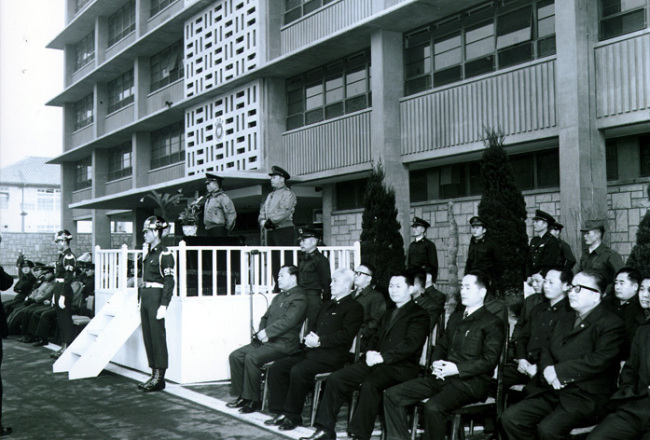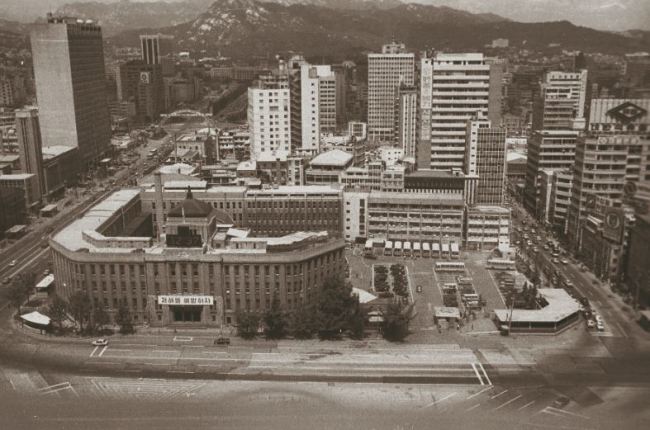The simple rectangular building in Gwanghwamun, which looks identical to the U.S. Embassy building in Seoul, was a symbol of a power shift in the modern history of Korea.
Initially built using an aid fund in the 1960s, the building was a center of political power, functioning as the headquarters of the Supreme Council for National Reconstruction, a military committee led by President Park Chung-hee, who had taken over the South Korean government in a coup d’etat.
Governing legislative, administrative and judicial powers, the committee set the foundations for the authoritative Park government, helping put together the five-year economic development plan that drove the landmark economic development of 1970s.
 |
An inauguration ceremony for the Supreme Council for National Reconstruction, a military committee led by President Park Chung-hee, who seized control of South Korea in a coup d’etat, takes place on Jan. 4, 1962, in front of what is now the National Museum of Korean Contemporary History. MMCA |
About 50 years later, the building has come to serve as the first national museum housing and preserving records of Korea’s modern and contemporary history.
Museums, the former Seoul City Hall building and public parks, all of which are central parts of the cityscape in Seoul, played an important part of the turbulent modern history of Korea. Their stories, overshadowed by the rapid changes the city underwent, are being revealed in two architecture exhibitions at the National Museum of Modern and Contemporary Art, Korea.
The first exhibition, held at the Seoul branch and co-organized by the museum and DOCOMOMO Korea, sheds light on the birth of major modern buildings in Seoul, and their demolition or survival amid the rapid upheaval of modernization in Korea.
The exhibition is being held along with the 13th DOCOMOMO International Conference, which ends on Monday in Seoul. The conference focused on the development processes and significance of modernism in the West and Asia, with a particular focus on modern architecture in Seoul.
Not every modern structure has been preserved in the capital city. The Japanese Government-General of Korea, Japan’s administrative center during its 35 years of colonial rule, was demolished on Aug. 15, 1995, as part of the attempt to scrap remains and evidence of the Japanese occupation. The building was reduced to a pile of rubble, to the cheering of crowds celebrating the 50th anniversary of independence from Japan.
The former Seoul City Hall building, once the municipal government building of Seoul, took a different path. Built during the Japanese colonial period, there were proposals in the 1980s and 1990s to relocate, demolish or reconstruct the building, but it was finally registered as a Cultural Heritage site by the government in 2003. It is now the Seoul Metropolitan Library.
 |
The former Seoul City Hall building in 1977 (MMCA) |
When Seoul was transforming through rapid economic development, the demand for modern buildings surged. Architect Kimm Jong-soung was one of the Korean architects frequently hired for new building projects. Having graduated from Illinois Institute of Technology and having practiced under the renowned German-American architect Ludwig Mies van der Rohe, Kimm was awarded ambitious architecture projects in Seoul.
Kimm’s legacies are on exhibit in the second exhibition, at the Gwacheon branch. Exhibits include sketches, blueprints and photographs of major buildings such as the SK Headquarters in Jongno-gu, the Millennium Seoul Hilton, the former stadium for weightlifting, Seoul National University Museum and Woo Yang Museum.
 |
The SK Group Headquarters in Jongno-gu, designed by the pioneering Korean modern architect Kimm Jong-soung (MMCA) |
The buildings were hailed as cutting-edge structures, and are still noted for their timeless design and versatile function amid contemporary architectural marvels built by foreign architects.
“Seoul has made a dramatic transition since I returned here 35 years ago. The city has become a place where today’s young generation can add better architecture. It would be ideal if young talents and the city make progress and evolve together,” said Kimm at the press preview of the exhibition last week.
Reflecting that big-name foreign architects are favored over Korean architects, Kimm said, “Sometimes, young talents don’t get a chance to position themselves in Korean contemporary architecture, but take up small interior projects.”
The exhibition “Rebirth of Place: Expansion and Conflict of the Korean Modern Architecture” runs through Dec. 14 at the Seoul branch of the MMCA. The “Harmony between Technology and Art: Architect Jong Soung Kimm” runs through April 26, 2015, at the Gwacheon branch of the MMCA. For more information, visit www.mmca.go.kr.
By Lee Woo-young (
wylee@heraldcorp.com)










